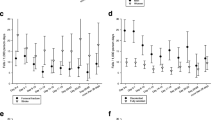Summary
Objective
To examine the impact of a fall prevention programme over a 12 month follow-up period after the introduction of a RCT and to describe possible differences between incidence density rate of falls associated with caregiver time during weekends and ordinary working days.
Design
Prospective observational study, duration 12 months.
Setting
Six community nursing homes, Germany.
Participants
Long-stay residents (n=881); 771 resident years; median age 85.0 years (min 60; max 101); 79.1% female.
Measurements
Incidence density rate of falls and fractures, staff time per resident.
Results
The incidence density rate over all days was 1367/1000 resident years (RY) for falls [95% confidence interval 1041;1693]. The incidence density rate of hip fractures was 29/1000 RY [95% confidence interval 12;45] and 29/1000 RY [95% confidence interval 12;45] for non-hip fractures. The incidence density rate showed similar results comparing weekends/ public holidays vs normal working days; falls 1193 vs 1447/ 1000 RY; hip fractures 25 vs 30/ 1000 RY and other fractures 16 vs 34/1000 RY.
Conclusion
During the period, we observed a marked decline of the fracture rate compared with the controlled phase of the intervention trial. A lower number of nursing care hours on weekends was not associated with a higher incidence density rate for falls, fallers, or any type of fracture.
Zusammenfassung
Ziel der Untersuchung
Untersuchung des Effekts eines Sturzpräventionsprogramms im Pflegeheimbereich in den 12 Verlaufsmonaten nach Abschluss der kontrollierten Phase unter Beteiligung der Warteeinrichtungen. Beschreibung der Inzidenzdichteraten der Ereignisse unter Beachtung der Pflegezeit im Vergleich von Werktagen und Wochenenden.
Studiendesign
Prospektive zwölfmonatige Beobachtungsstudie.
Setting
Sechs Pflegeeinrichtungen einer Stadt in Süddeutschland.
Teilnehmer
881 Heimbewohner (771 Bewohnerjahre), Altersmedian 85,0 (Min. 60, Max. 101) davon 79,1% Frauen.
Messungen
Inzidenzdichteraten der Stürze und Frakturen, verfügbare Arbeitszeit der Pflegemitarbeiter.
Ergebnisse
Die Inzidenzdichterate lag bei 1367/1000 Bewohnerjahre (BJ) für Stürze [95% Konfidenzintervall (KI) 1041;1693]. Die Inzidenzdichterate der PFF lag bei 29/1000 BJ [95% KI 12;45] and 29/1000 BJ [95% KI 12;45] für andere Frakturen. Die Inzidenzdichteraten zeigten vergleichbare Zahlen an Wochentagen und Wochenenden sowohl bei Stürzen 1193 vs. 1447/ 1000 BJ; Hüftfrakturen 25 vs. 30/ 1000 BJ und bei anderen Frakturen 16 vs. 34/1000 RY.
Zusammenfassung
Im Beobachtungszeitraum kam es zu einem deutlichen Rückgang der Frakturraten gegenüber dem Zeitraum der kontrollierten Phase der Interventionsstudie. Eine niedrige Arbeitszeit am Wochenende und an Feiertagen war nicht mit einer erhöhten Sturz- und Frakturhäufigkeit verbunden
Similar content being viewed by others
Literatur
Aiken L, Clarke S, Douglas M, Sloane D, Sochalski J, Silber J (2002) Hospital nurse staffing and patient mortality, nurse burnout, and job dissatisfaction. J Am Med Ass 288:1987–1993
Arbesman MC, Wright C (1999) Mechanical restraints, rehabilitation therapies, and staffing adequacy as risk factors for falls in an elderly hospitalized population. Rehabilitation Nursing 24:122–128
Becker C, Kron M, Lindemann U, Sturm, Eichner B, Walter-Jung B, Nikolaus Th (2003) Effectiveness of a multifaceted intervention on falls in nursing home residents. J Am Geriat Soc 51:306–313
Blake C, Morfitt JM (1986) Falls and staffing in a residential home for elderly people. Public Health 100:385–391
Cali CM, Kiel DP (1995) An epidemiologic study of fall-related fractures among institutionalized older people. J Am Geriatr Soc 43:1336–1340
Dolinis J, Harrison JE, Andrews GR (1997) Factors associated with falling in older Adelaide residents. Aust New Zealand J Publ Health 21:462–468
Donner A, Klar N (2000) Design and analysis of cluster randomization trials in health care. Arnold, London 106:132–133
Gillespie LD, Gillespie WJ, Cumming R, Lamb SE, Rowe BH (2001) Interventions for preventing falls in the elderly. Cochrane Database of Systematic Reviews
Harrington C, Zimmermann, Karon SL, Robinson J, Beutel P (2000) Nursing home staffing and its relationship to deficiencies. J Gerontol B Psych Sci Soc Sci 55:278–287
Jensen J, Lundin-Olsson L, Nyberg L, Gustavson Y (2002) Fall and injury prevention in older people living in residential care facilities. A cluster randomized trial. Ann Intern Med 136:733–741
Jørstad EC, Hauer K, Becker C, Nakash R, Skelton DA, Lamb SA, on behalf of the ProFaNE Group (2005 b) Physical activity questionnaires in fall prevention intervention trials: a systematic review. J Aging Phys Activ, pp 461–481
Kiely DK, Kiel DP, Burrows AB, Lipsitz LA (1998) Identifying nursing home residents at risk for falling. J Am Geriat Soc 46:551–556
Kovner C (2001) The impact of staffing and the organization of work on patient outcomes and health care workers in health care organizations. Jt Comm J Qual Improv 27:458–468
Kron M, Loy S, Nikolaus Th, Becker C (2003) Risk factors for falls in institutionalised frail elderly. Am J Epidem, pp 645–653
Lamb SE, Jørstad EC, Hauer K, Becker C (2005) Development of a common outcome data set for fall injury prevention trials. J Am Geriat Soc, pp 1688–1622
Luukinen H, Koski K, Laippal P, Kivela SL (1995) Risk factors for recurrent falls in the elderly in long-term institutional care. Public Health 109:57–65
Meyer G, Warnke A, Bender R, Mühlhauser I (2003) Effect on hip fractures in nursing homes: cluster randomised controlled trial. Br Med J 326:1–5
Myers AH, Baker SP, van Natta ML, Abbey H, Robinson EG (1991) Risk factors associated with falls and injuries among elderly institutionalized persons. Am J Epid 133:1179–1190
Needleham J, Buerhaus P, Mattke S, Stewart M, Zelevinsky K (2002) Nurse-staffing levels and the quality of care in hospitals. N Engl J Med 346:1715–1722
Rubenstein LZ, Josephson KR, Osterweil D (1996) Falls and fall prevention in the nursing home. Clin Geriat Med 12:881–902
Thapa PB, Brockman KG, Gideon P, Fought RL, Ray WA (1996) Injurious falls in nonambulatory nursing home residents: A comparative study of circumstances, incidence, and risk factors. J Am Geriat Soc 44:273–278
Author information
Authors and Affiliations
Rights and permissions
About this article
Cite this article
Becker, C., Loy, S., Nikolaus, T. et al. A follow-up study on fall and fracture incidence in long-term care including the role of formal caregiver time on fall incidence rates. Z Gerontol Geriatr 39, 292–296 (2006). https://doi.org/10.1007/s00391-006-0399-x
Received:
Accepted:
Issue Date:
DOI: https://doi.org/10.1007/s00391-006-0399-x




